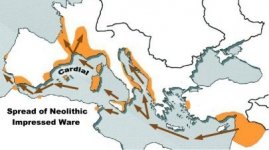Yes, apparently it is only through GENO. The thought at u 152 admin is that my PF4363 MAY be a clan marker. My two closest matches are taking the test also. So, under u 152, PF4363 may be a clan marker. This would be something, for sure.
Both my matches probably occurred within 12 generations. But the question is, where is the origin point for u 152 ? And then, what clan would that signify ? I have strong hints from Geno, DNA Tribes etc, of links to Tuscany and the Aegaen/ Thrace, with Romania being very strong. I am an Englishman... so how did my ancestor get into Britain ?
Spartacus, of course, was a "Celtic" Thracian Gladiator, and probably u152.
Got to dig up the dead I think, once Ydna on ancient remains gets somewhere. Until then, we are only guessing.
The admin of our project, himself a u152 * previously, is a Hungarian I THINK of Romanian descent... but is not PF4363.
Of course, my post was due to the idea that this DNA spread about through the movements of the Roman Legions. It is found in China to Britain, pretty well following the limits of the Roman Empire. This is my present thought , which changes often

Rich






